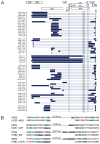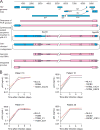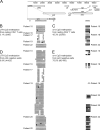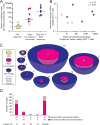Replication-competent noninduced proviruses in the latent reservoir increase barrier to HIV-1 cure
- PMID: 24243014
- PMCID: PMC3896327
- DOI: 10.1016/j.cell.2013.09.020
Replication-competent noninduced proviruses in the latent reservoir increase barrier to HIV-1 cure
Abstract
Antiretroviral therapy fails to cure HIV-1 infection because latent proviruses persist in resting CD4(+) T cells. T cell activation reverses latency, but <1% of proviruses are induced to release infectious virus after maximum in vitro activation. The noninduced proviruses are generally considered defective but have not been characterized. Analysis of 213 noninduced proviral clones from treated patients showed 88.3% with identifiable defects but 11.7% with intact genomes and normal long terminal repeat (LTR) function. Using direct sequencing and genome synthesis, we reconstructed full-length intact noninduced proviral clones and demonstrated growth kinetics comparable to reconstructed induced proviruses from the same patients. Noninduced proviruses have unmethylated promoters and are integrated into active transcription units. Thus, it cannot be excluded that they may become activated in vivo. The identification of replication-competent noninduced proviruses indicates that the size of the latent reservoir-and, hence, the barrier to cure-may be up to 60-fold greater than previously estimated.
Copyright © 2013 Elsevier Inc. All rights reserved.
Figures







Comment in
-
Stochastic fate selection in HIV-infected patients.Cell. 2013 Oct 24;155(3):497-9. doi: 10.1016/j.cell.2013.09.039. Epub 2013 Oct 24. Cell. 2013. PMID: 24243007
Similar articles
-
Sequence Evaluation and Comparative Analysis of Novel Assays for Intact Proviral HIV-1 DNA.J Virol. 2021 Feb 24;95(6):e01986-20. doi: 10.1128/JVI.01986-20. Print 2021 Feb 24. J Virol. 2021. PMID: 33361426 Free PMC article.
-
Identification of Genetically Intact HIV-1 Proviruses in Specific CD4+ T Cells from Effectively Treated Participants.Cell Rep. 2017 Oct 17;21(3):813-822. doi: 10.1016/j.celrep.2017.09.081. Cell Rep. 2017. PMID: 29045846 Free PMC article.
-
Low Inducibility of Latent Human Immunodeficiency Virus Type 1 Proviruses as a Major Barrier to Cure.J Infect Dis. 2021 Feb 15;223(12 Suppl 2):13-21. doi: 10.1093/infdis/jiaa649. J Infect Dis. 2021. PMID: 33586775 Free PMC article. Review.
-
Genetic Diversity, Compartmentalization, and Age of HIV Proviruses Persisting in CD4+ T Cell Subsets during Long-Term Combination Antiretroviral Therapy.J Virol. 2020 Feb 14;94(5):e01786-19. doi: 10.1128/JVI.01786-19. Print 2020 Feb 14. J Virol. 2020. PMID: 31776273 Free PMC article.
-
Measuring replication competent HIV-1: advances and challenges in defining the latent reservoir.Retrovirology. 2018 Feb 13;15(1):21. doi: 10.1186/s12977-018-0404-7. Retrovirology. 2018. PMID: 29433524 Free PMC article. Review.
Cited by
-
Footprints of innate immune activity during HIV-1 reservoir cell evolution in early-treated infection.J Exp Med. 2024 Nov 4;221(11):e20241091. doi: 10.1084/jem.20241091. Epub 2024 Oct 28. J Exp Med. 2024. PMID: 39466203 Clinical Trial.
-
Neurosymptomatic HIV-1 CSF escape is associated with replication in CNS T cells and inflammation.J Clin Invest. 2024 Oct 1;134(19):e176358. doi: 10.1172/JCI176358. J Clin Invest. 2024. PMID: 39352388 Free PMC article.
-
Sirolimus reduces T cell cycling, immune checkpoint marker expression, and HIV-1 DNA in people with HIV.Cell Rep Med. 2024 Oct 15;5(10):101745. doi: 10.1016/j.xcrm.2024.101745. Epub 2024 Sep 24. Cell Rep Med. 2024. PMID: 39321793 Free PMC article.
-
Integrator complex subunit 12 knockout overcomes a transcriptional block to HIV latency reversal.bioRxiv [Preprint]. 2024 Sep 28:2024.08.30.610517. doi: 10.1101/2024.08.30.610517. bioRxiv. 2024. PMID: 39257755 Free PMC article. Preprint.
-
Machine learning approaches identify immunologic signatures of total and intact HIV DNA during long-term antiretroviral therapy.Elife. 2024 Sep 9;13:RP94899. doi: 10.7554/eLife.94899. Elife. 2024. PMID: 39250423 Free PMC article.
References
-
- Bebenek K, Abbotts J, Roberts JD, Wilson SH, Kunkel TA. Specificity and mechanism of error-prone replication by human immunodeficiency virus-1 reverse transcriptase. J Biol Chem. 1989;264:16948–16956. - PubMed
Publication types
MeSH terms
Associated data
- Actions
- Actions
- Actions
- Actions
- Actions
- Actions
- Actions
- Actions
- Actions
- Actions
- Actions
- Actions
- Actions
- Actions
- Actions
- Actions
- Actions
- Actions
- Actions
- Actions
- Actions
- Actions
- Actions
- Actions
- Actions
- Actions
- Actions
- Actions
- Actions
- Actions
- Actions
- Actions
- Actions
- Actions
- Actions
- Actions
- Actions
- Actions
- Actions
- Actions
- Actions
- Actions
- Actions
- Actions
- Actions
- Actions
- Actions
- Actions
- Actions
- Actions
- Actions
- Actions
- Actions
- Actions
- Actions
- Actions
- Actions
- Actions
- Actions
- Actions
- Actions
- Actions
- Actions
- Actions
- Actions
- Actions
- Actions
- Actions
- Actions
- Actions
- Actions
- Actions
- Actions
- Actions
- Actions
- Actions
- Actions
- Actions
- Actions
- Actions
- Actions
- Actions
- Actions
- Actions
- Actions
- Actions
- Actions
- Actions
- Actions
- Actions
- Actions
- Actions
- Actions
- Actions
- Actions
- Actions
- Actions
- Actions
- Actions
- Actions
- Actions
- Actions
- Actions
- Actions
- Actions
- Actions
- Actions
- Actions
- Actions
- Actions
- Actions
- Actions
- Actions
- Actions
- Actions
- Actions
- Actions
- Actions
- Actions
- Actions
- Actions
- Actions
- Actions
- Actions
- Actions
- Actions
- Actions
- Actions
- Actions
- Actions
- Actions
- Actions
- Actions
- Actions
- Actions
- Actions
- Actions
- Actions
- Actions
- Actions
- Actions
- Actions
- Actions
- Actions
- Actions
- Actions
- Actions
- Actions
- Actions
- Actions
- Actions
- Actions
- Actions
- Actions
- Actions
- Actions
- Actions
- Actions
- Actions
- Actions
- Actions
- Actions
- Actions
- Actions
- Actions
- Actions
- Actions
- Actions
- Actions
- Actions
- Actions
- Actions
- Actions
- Actions
- Actions
- Actions
- Actions
- Actions
- Actions
- Actions
- Actions
- Actions
- Actions
- Actions
- Actions
- Actions
- Actions
- Actions
- Actions
- Actions
- Actions
- Actions
- Actions
- Actions
- Actions
- Actions
- Actions
- Actions
- Actions
- Actions
- Actions
- Actions
- Actions
- Actions
- Actions
- Actions
- Actions
- Actions
- Actions
- Actions
- Actions
- Actions
- Actions
- Actions
- Actions
- Actions
- Actions
- Actions
- Actions
- Actions
Grants and funding
LinkOut - more resources
Full Text Sources
Other Literature Sources
Medical
Molecular Biology Databases
Research Materials

